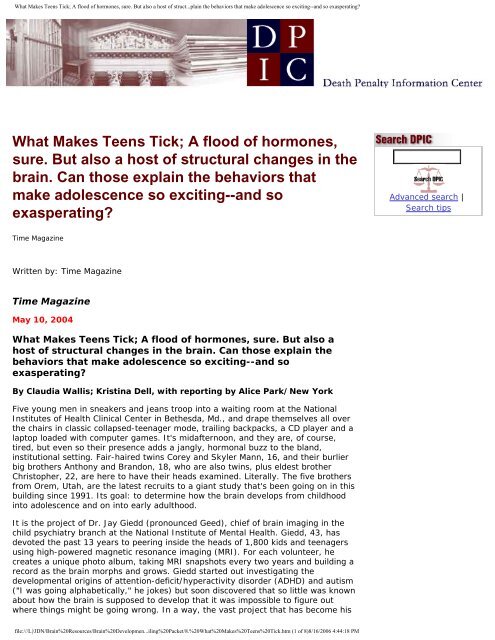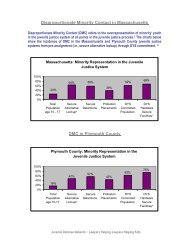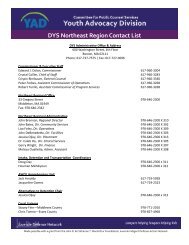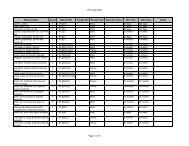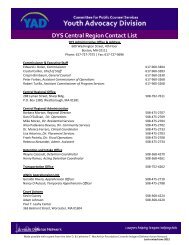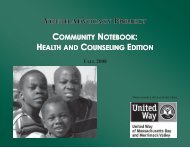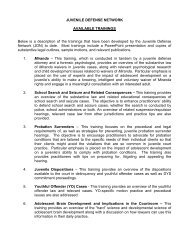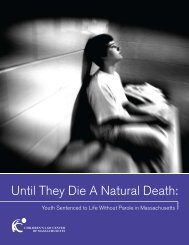States rethink 'adult time for adult crime' - the Youth Advocacy Division
States rethink 'adult time for adult crime' - the Youth Advocacy Division
States rethink 'adult time for adult crime' - the Youth Advocacy Division
You also want an ePaper? Increase the reach of your titles
YUMPU automatically turns print PDFs into web optimized ePapers that Google loves.
What Makes Teens Tick; A flood of hormones, sure. But also a host of struct...plain <strong>the</strong> behaviors that make adolescence so exciting--and so exasperating<br />
What Makes Teens Tick; A flood of hormones,<br />
sure. But also a host of structural changes in <strong>the</strong><br />
brain. Can those explain <strong>the</strong> behaviors that<br />
make adolescence so exciting--and so<br />
exasperating<br />
Advanced search |<br />
Search tips<br />
Time Magazine<br />
Written by: Time Magazine<br />
Time Magazine<br />
May 10, 2004<br />
What Makes Teens Tick; A flood of hormones, sure. But also a<br />
host of structural changes in <strong>the</strong> brain. Can those explain <strong>the</strong><br />
behaviors that make adolescence so exciting--and so<br />
exasperating<br />
By Claudia Wallis; Kristina Dell, with reporting by Alice Park/New York<br />
Five young men in sneakers and jeans troop into a waiting room at <strong>the</strong> National<br />
Institutes of Health Clinical Center in Be<strong>the</strong>sda, Md., and drape <strong>the</strong>mselves all over<br />
<strong>the</strong> chairs in classic collapsed-teenager mode, trailing backpacks, a CD player and a<br />
laptop loaded with computer games. It's midafternoon, and <strong>the</strong>y are, of course,<br />
tired, but even so <strong>the</strong>ir presence adds a jangly, hormonal buzz to <strong>the</strong> bland,<br />
institutional setting. Fair-haired twins Corey and Skyler Mann, 16, and <strong>the</strong>ir burlier<br />
big bro<strong>the</strong>rs Anthony and Brandon, 18, who are also twins, plus eldest bro<strong>the</strong>r<br />
Christopher, 22, are here to have <strong>the</strong>ir heads examined. Literally. The five bro<strong>the</strong>rs<br />
from Orem, Utah, are <strong>the</strong> latest recruits to a giant study that's been going on in this<br />
building since 1991. Its goal: to determine how <strong>the</strong> brain develops from childhood<br />
into adolescence and on into early <strong>adult</strong>hood.<br />
It is <strong>the</strong> project of Dr. Jay Giedd (pronounced Geed), chief of brain imaging in <strong>the</strong><br />
child psychiatry branch at <strong>the</strong> National Institute of Mental Health. Giedd, 43, has<br />
devoted <strong>the</strong> past 13 years to peering inside <strong>the</strong> heads of 1,800 kids and teenagers<br />
using high-powered magnetic resonance imaging (MRI). For each volunteer, he<br />
creates a unique photo album, taking MRI snapshots every two years and building a<br />
record as <strong>the</strong> brain morphs and grows. Giedd started out investigating <strong>the</strong><br />
developmental origins of attention-deficit/hyperactivity disorder (ADHD) and autism<br />
("I was going alphabetically," he jokes) but soon discovered that so little was known<br />
about how <strong>the</strong> brain is supposed to develop that it was impossible to figure out<br />
where things might be going wrong. In a way, <strong>the</strong> vast project that has become his<br />
file:///L|/JDN/Brain%20Resources/Brain%20Developmen...iling%20Packet/8.%20What%20Makes%20Teens%20Tick.htm (1 of 8)8/16/2006 4:44:18 PM


